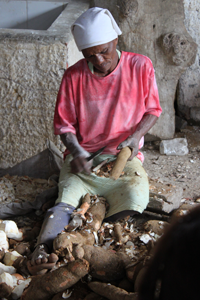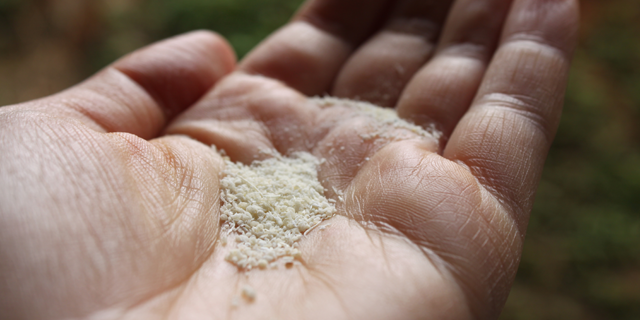Manioc (also known as cassava or yuca) has been a cornerstone of Amazon cooking for more than 7,000 years, during which time it has made its way around the world, becoming a staple of Latin cooking, as well. The starchy shrub is native to South America and is extensively cultivated in tropical regions, where it can stand up to heat and drought. The tree is valued for its roots – starchy, carb-laden, and virtually indestructible.
There are two varieties of the root: sweet and bitter. Sweet manioc, often referred to as yuca in Latin America, requires no special processing and can be consumed raw. This is what you see at the market, a long root usually stocked with potatoes and yams. It’s especially prized for it’s thickening properties, making it a valuable addition to stews, bread, tortillas, and desserts.
The bitter variety of manioc, particularly important in Brazilian cuisine, is naturally toxic, containing deadly concentrations of cyanide compounds. Unless you seek it out and source it, it's extremely unlikely you'll come across this variety in the United States. Before consumption, this bitter root must be processed through some combination of peeling, grating, pressing, soaking, boiling, and drying.

The other is polvilho, or tapioca, the starch of the manioc and a dehydrated bi-product of the farinha process. Tapioca, of course, is now used throughout the world and has become an important stabilizing ingredient in molecular gastronomy.
But the root isn’t the only usable part of the manioc shrub. The manioc’s liquid, tucupi, is known for its distinct flavor and bright yellow color, and is widely used throughout the north of Brazil as a base for for soups and stews. Also edible are the leaves of the plant, which can be cooked down to create dishes of bitter greens, the most popular of which is known as maniçoba.
So how will you use manioc? First, when purchasing, look for a strong, sturdy root with no soft spots and the ends still intact. To prepare, cut off the ends and discard and cut the manioc into 3- or 4-inch sections. Then using your knife, peel off the thick skin (it's usually too thick for a vegetable peeler). Finally, core the dense, wooden chunk in the center out of each section. You're now ready to cook and enjoy.


![Making Mealtime Matter with La Familia: Easy Sofrito [Video]](https://thelatinkitchen.com/wp-content/uploads/2015/10/sofrito-shutterstock__0-500x383.jpg)
![Easy Latin Smoothies: Goji Berry Smoothie [Video]](https://thelatinkitchen.com/wp-content/uploads/2015/12/goji_berry-shutterstock_-500x383.jpg)
















![Fun and Fast Recipes: Fiesta Cabbage Salad [Video]](https://thelatinkitchen.com/wp-content/uploads/2015/11/fiesta_cabbage_slaw-shutterstock_-500x383.jpg)









